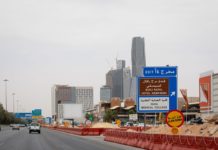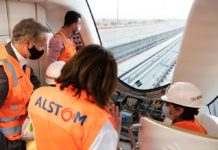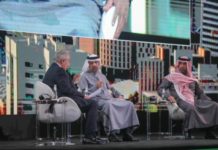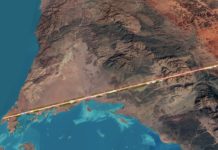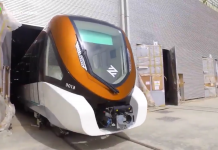Riyadh’s new six-line metro – the world’s biggest urban rail project outside China – is on budget and expected to open in the second half of 2020.
Alwalid Alekrish, deputy CEO, programmes and projects with Riyadh Development Authority, explains to David Briginshaw, how it has been possible to keep control of such a huge project.
THE population of the Saudi capital Riyadh is 6.9 million and is growing at the rate of 3.5% a year, compared with a world average of 2.5%, and is expected to reach 8.3 million by 2030. There are two million cars in Riyadh with an average of two cars per household. The average commercial speed is 45km/h, but this will drop to 18km/h by 2030 if nothing is done to change the modal split.
Perversely, Riyadh is almost devoid of any public transport apart from taxis. Even walking in Riyadh is a challenge, apart from the heat, as most streets do not have anywhere safe to walk. There are 10 million trips per day in Riyadh but only 2% are by public transport, while 80% are by private car.
But all this is about to change as Riyadh nears the completion of one of the world’s most ambitious transport projects: the construction of a 176km six-line fully-automated metro serving 85 stations and a complimentary 1900km bus network with around 3000 stops.
“We have gone from zero to automatic testing of the metro in just five years,” Mr Alwalid Alekrish, deputy CEO, programmes and projects with Riyadh Development Authority (RDA), told IRJ during an exclusive interview at the UITP’s Global Public Transport Summit in Stockholm in June. “The project is being delivered without major delays or budget overruns.”
According to the three main contracts awarded (see panel), the official start of the project was in October 2013, with ground-breaking following in April 2014 (see timeline). Alekrish says the first three lines will open in mid-2020. “We will open lines 2, 3 and 4 first, which is one line from each consortium. This is logical, because there is a lot of work to do. This will be just a few months before the remaining lines open. By the end of 2020 we will have launched the whole system.”
Riyadh metro timeline April 2014: Ground breaking
March 2015: First viaduct installed
April 2015: First TBM launched
November 2016: First train arrives
December 2016: Tunnelling completed
February 2018: First line section energised
April 2018: Start of train testing
September 2018: O&M contract awarded
June 2019: Project reaches 83% completion
2H 2020: First three lines open
End 2020: Remaining three lines open
Incidentally, the bus network is due to open in the fourth quarter of this year and will offer three levels of service. Two north-south bus rapid transit (BRT) lines will be operated by articulated vehicles. The BRT lines will be complemented by a network of community buses operated with standard single-deck vehicles, and local feeder services using smaller vehicles. RDA expects the 80-line bus network to carry around 2 million passengers per day initially, rising to 4.6 million in the longer term.
RDA says there are three main elements which have contributed to the success of the metro project:
- project planning and design which started in 2001 with studies identifying the city’s high-density corridors followed by the approval process
- management and engineering which led to the appointment of three consortia to build and equip the metro network, and
- clear communication with citizens which RDA says is essential for such a large project.
The metro has involved constructing 85km of viaducts, 36km of tunnels using seven TBMs as well as the New Austrian Tunnelling Method for a short section, and 360km of utility diversions. RDA says around 56,000 people have worked on the project and that a very high level of safety has been achieved during construction.
Alekrish says that 80 of the 85 metro stations are located in the median of roads which made utility diversion a major challenge. “We worked with the utility companies within the project management office from the outset,” Alekrish explains. “We brought one or two people from each utility company to sit with the project team and interface with their companies. This worked very well, and within one to two-and-a-half years we had diverted more than 300km of utilities.”
Another major challenge was ensuring road traffic would continue to flow freely around the numerous construction sites throughout the city. “Our concern was that building six metro lines at once could shut the city down,” Alekrish says. RDA worked with multiple stakeholders, the traffic police and citizens to mitigate the effects of the diversions. Models to gauge the impact of planned diversions on road traffic were developed for each phase of construction. Each consortium produced its own traffic models which RDA incorporated into one large model for the city.
“It was very complicated in the beginning, but it went very smoothly in the end,” Alekrish says. “In some cases, it turned out better than before as some people want to keep the detours in place.”
Public engagement was a high priority for RDA from the outset. “Before we announced road diversions in the media, we would go to stakeholders to explain what to expect and left them with personal contact details so that people could feel part of the project,” Alekrish says. “We also created an app to show diversions the day before they were introduced – a lot of people used the app.”
Engagement with the public
Engagement with the public started before work on the project began with a competition for children who were asked to depict their idea of a metro and public transport system. “We took all of the entries, enlarged them, and displayed them around the sites of future stations where the children lived,” Alekrish told IRJ. “This was a very important first step as our main objective was to educate the public through young people.
“We also had a TBM naming competition and gave prizes to the winners, which helped to make people feel engaged with the project. During construction, when we had a TBM breakthrough, we invited people living near the site to see the event.
“We also have a call centre to provide information to the public and a direct line to the project team. We aim to give a response to questions within 24 hours.
“We have a public visitor centre with pre-arranged visits for schools where they can see mock-ups of the trains.
We also engaged 100 students and gave them public transport training so that they could visit schools. We have visited more than 50% of the schools in Riyadh and received good feed-back from parents. We also encourage people to visit the new stations and we are considering whether to invite the public for test rides.”
RDA conducted a naming rights competition in November 2018 and awarded eight companies rights to use their brand as the name of a metro station. The 10-year contracts will raise just over Riyals 1bn ($US 267m). RDA is also considering naming its fare cards.
In addition, RDA has a student training programme to encourage people to work on the project. Initially it conducted a 10-week summer course in civil engineering in collaboration with Saudi universities. There was also an eight-week course covering metro systems with six weeks training in Saudi Arabia followed by two weeks training abroad with railway equipment suppliers. RDA also offered internships. “This worked so well that people were coming to us for placements,” Alekrish says. “Some of these people have gone on to work on the project. We are also working with the contractors to encourage some of their staff to work on the operating side. It is a win-win situation.”
Road reconfiguration
An important part of the metro project is the reconfiguration of roads which follow the alignment of the metro lines. According to RDA’s metro urban design and streetscape manual published in 2014: “the success of the metro not only requires acknowledging the importance of a high-quality public transport system but also a change in the current perception of a vehicular-reliant society. This change is ultimately based on shifting the present planning priority from a vehicular one to that of a multi-modal system. Fundamental to this shift is the quality provision of the public realm or streetscape in which the metro will operate.”
German architects Albert Speer and Partners were appointed as consultant for the project, which will provide walkways, 135 cycle paths, and street lighting. In addition, trees are being planted and canopies constructed to provide shade for pedestrians. “We are planting 7.5 million trees which will reduce the temperature in the city by around 2oC,” Alekrish explains. “We want to create an urban realm and to encourage people to walk. It is a paradigm change.”
All the heavy construction has been completed and around 30% of the road detours have now been removed. “Fitting out is going very well, and we are above 80% completion of the project,” Alekrish told IRJ. “Almost all of the trains have been delivered. Test running has already started on lines 2, 3 and 4, and will begin soon on lines 1, 5 and 6. Our operators are on-board, and are recruiting staff and preparing for operation.”
All stations will be air-conditioned to provide passengers with a comfortable environment during the intense heat of the Saudi summer. There will also be four main stations on the network – King Abdullah Financial District, Olaya, Qasr Al Hokom and Western – which have been designed by world-renowned architects. The first three are metro interchanges, and all four will act as transport hubs where bus and metro services will be integrated.
The metro is forecast to carry around 1.2 million passengers per day initially with three-minute headways. Only Line 1/Blue will be operated with four-car trains from the outset, although all stations are designed to accommodate four-car trains. As traffic builds up, headways will be reduced to 90 seconds and full-length trains will be introduced. Ridership is expected to grow to 3.6 million passengers/day within 10 years.
“It will probably be sooner than we expect when we go to four-car operation,” Alekrish predicts. “We are already getting requests to extend the network to other parts of the city, and we are studying a three-phase expansion programme. The first phase will probably add around 50km of extensions to the existing network and possibly a new line as well. We could move to phase one very soon.”
When the bus network and metro are fully operational, Riyadh will jump from having virtually no public transport at all, to having a comprehensive network serving most parts of the city and the world’s largest driverless metro network. This is an impressive achievement which few other cities in the world have attempted. The biggest challenge, however, will be to persuade Saudis to leave their cherished cars at home and switch to public transport.
An international project
CONSTRUCTION of Riyadh’s six-line metro is being implemented by three international consortia: Fast led by Spanish construction group FCC, the Arriyadh New Mobility Group (ANM) led by Hitachi Rail STS, and the BACS consortium led by Bechtel.
The Fast consortium members include Alstom; Samsung C&T; Strukton, Netherlands; Freyssinet, Saudi Arabia; Typsa, Spain; and Setec, France. Fast is building three lines totalling 73km at a cost of $US 7.82bn. These comprise the 30km Line 4/Gold, the 13km Line 6/Purple, which share a common section between King Adbullah Financial District and Sabic, the 25km Line 5/Green along King Abdullah Road. The contract includes the construction of 29.8km of viaduct and 26.6km of tunnels.
Alstom’s share is worth around $US 1.6bn and includes a fleet of 69 Metropolis trains, together with Communications Based Train Control (CBTC), Hesop energy recovery system, and its Appitrack tracklaying system. The 36m-long two-car trains will be 2.71m wide
ANM is responsible for constructing the 40.7km Line 3/Orange under a contract worth $US 5.21bn. Hitachi Rail STS’s partners in ANM include civil works contractors Salini-Impreglio, Larsen & Toubro, and Nemsa, together with Bombardier, which will supply a fleet of 47 two-car trains.
Hitachi STS’ share is worth $US 680m and covers automatic train control (ATC), CBTC, power supplies including third-rail electrification, the operational control centre, telecommunications, and fitting out depots. The contract includes an option for 10 years’ maintenance.
The BACS consortium is building the 39km north-south Line 1/Blue and the 30km east-west Line 2/Red. The consortium includes Aecom and Siemens, and the contract has a total value of $US 9.45bn.
Siemens is supplying 45 75.7m-long four-car trains – the only four-car trains on the network – for Line 1/Blue and 29 two-car trains for Line 2/Red. Each four-car train will accommodate 522 passengers at 4 passengers/m2, 123 of them seated.
All the trains are being built to a common design and will have three classes of accommodation: first, family, and single. Trains for each line will be branded with the line colour. The network is electrified at 750V dc third rail.
O&M contract
RIYADH Development Authority (RDA) awarded two 12-year operation and maintenance contracts covering two groups of lines in September 2018.
The largest contract worth Riyals 10.9bn ($US 2.9bn) covering lines 3, 4, 5 and 6 went to the Flow consortium of Alstom, Hitachi Rail STS and Italian State Railways (FS). The Capital Metro Company (Camco) joint venture of RATP Dev and Saudi Public Transport Company (Saptco) won the contract for lines 1 and 2.
The contracts cover metro operation, security, passenger assistance, facility and building maintenance, and maintenance of the trains, signalling, telecommunications, power supply, and passenger information systems.
The contractors will have to meet globally-recognised KPIs for metro operation and maintenance. They will also be expected to meet a Saudisation target of 45% by offering a range of positions for Saudi men and women and a minimum of 55% local content for supplies and services related to the operation of the metro. More
By David Briginshaw https://www.railjournal.com

